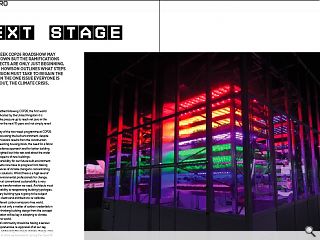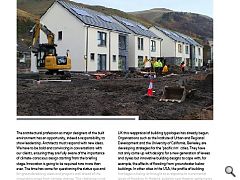Net Zero: The Next Stage
18 Jan 2022
The two-week Cop26 roadshow may have left town but the ramifications for architects are only just beginning. Here Leslie Howson outlines what steps the profession must take to regain the initiative on the one issue everyone is talking about, the climate crisis.
Now the dust has settled following COP26, the first world climate conference hosted by the United Kingdom it is important to keep the pressure up to reach net zero in the building industry over the next 10 years and not simply revert to the status quo.
Only the final day of the two-week programme at COP26 was given over to discussing the built environment, despite 40% of all carbon emissions results from the construction sector. Retrofitting existing housing stock, the need for a fabric first and building resilience approach and for better building codes were all highlighted but little was said about the wider conceptual design aspects of new buildings. Significant responsibility for our future built environment lies with architects who now have to progress from talking about the consequences of climate change to concentrating on delivering design solutions.
Whilst there is a high level of support amongst environmental professionals for change, simply trying harder at conventional sustainability is very unlikely to deliver the transformation we need. Architects must look beyond sustainability to reappraising building typologies, for soon, almost every building type is going to be subject to change requiring clients and architects to re-calibrate their minds for a different carbon emissions-free world. Achieving net-zero is not only a matter of carbon credentials in construction but re-thinking building design from the concept stage. Design innovation will be key in adapting to climate change in a pandemic world. The architectural community should be having a serious debate about a comprehensive re-appraisal of all our key building typologies, addressing this major climate change crisis, also taking account of what we have learnt during the Covid 19 crisis.
The challenge to decarbonise is immense and immediate. The architectural profession as major designers of the built environment has an opportunity, indeed a responsibility, to show leadership. Architects must respond with new ideas. We have to be bold and convincing in conversations with our clients, ensuring they are fully aware of the importance of climate-conscious design starting from the briefing stage. Innovation is going to be required now more than ever. The time has come for questioning the status quo and for groundbreaking ideas and projects well ahead of the impending crises from climate change. This challenge is not just about how we construct buildings but about a wider focus on the whole concept of what our key buildings might be like in the future.
For example, hospitals are currently reliant on huge energy use 24/7, this will need to be rethought with greater consideration given to using green energy systems. Autonomous houses supplying their power, heat and even food from solar energy might be a better concept for the future. Architects will also need to address specific consequences of climate change such as solutions that mitigate flooding and the effects of rising sea and, inevitably, rising groundwater levels, as well as new ideas about the effect the form and mass of key buildings have on their carbon credentials. Outside the UK this reappraisal of building typologies has already begun. Organisations such as the Institute of Urban and Regional Development and the University of California, Berkeley, are developing strategies for the ‘pacific rim` cities.
They have not only come up with designs for a new generation of levees and dykes but innovative building designs to cope with, for example, the effects of flooding from groundwater below buildings. In other cities in the USA, the profile of building frontages is being re-thought as a response to incremental levels of flooding. In Holland, building new floating settlements in coastal cities like Rotterdam is becoming the norm. If the predictions are correct, particular areas of the coastline of the British Isles, especially in Scotland, all of whose major cities are coastal, will be similarly impacted by more frequent flooding and sea-level rise requiring an equivalent level of re-appraisal of the landscape and the buildings. Innovative architectural design solutions will be required to address these and other consequences of climate change.
Architects, as much as any group of professionals, are now in the driving seat, steering us towards a carbon-free future. This challenge is new and very different to anything that has gone before in architectural design history.




